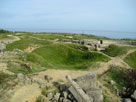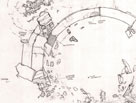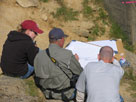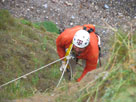|
Texas A&M University researchers said Wednesday that serious
erosion problems pose a significant threat to the historic Pointe
Du Hoc battle site in Normandy, where one of the most important
battles of the June 6, 1944 D-Day invasion – and World
War II overall — was fought.
The combination of groundwater at the site and constant wave
erosion pounding from the English Channel means a large portion
of the site potentially could fall into the sea, the researchers
said.
Pointe Du Hoc and its 90-foot cliffs were scaled by then-Lt.
Col. Earl Rudder and his Rangers during the D-Day invasion, at
a high cost. Of the 225 Rangers who participated in trying to
scale the cliffs, only 90 lived through the day as the Germans
rained down grenades and machine gun fire at the soldiers. Rudder
would go on to become president of Texas A&M in 1959 and
served until his sudden death in 1970, and many consider him
to be the school’s greatest president — it was he
who urged women to be allowed to attend the all-male military
school; and he also made membership in the Corps of Cadets voluntary.
Texas A&M has led a research team to the site for the past
three years, and its efforts have been featured on the History
Channel show Battlefield Detectives.
The research team told U.S. Rep. Chet Edwards, himself a Texas
A&M graduate, that the Pointe Du Hoc site is in serious decay
and will only get worse unless major work is done to preserve
it. Edwards helped secure $500,000 in federal support to the
site in 2005 and another $300,000 this year.
“In my opinion, this is one of the most important sites of the
20th century,” said Richard Burt, assistant professor of
construction science and member of the research team.
“World War II is the major event of the 20th century, the D-Day
invasion was the most important event of the war and Pointe Du
Hoc was likely the most important battle of D-Day. The heroism
that was displayed there on that day was just incredible. Gen.
Omar Bradley later said it was probably the most dangerous mission
he’d ever seen.
“There are memorials to Americans and Germans who died there,” Burt
added. “Two U.S. presidents delivered keynote speeches
at Pointe Du Hoc during the 40th and 50th anniversaries of the
battle. The battleship Texas pounded the area with shelling during
the invasion and Earl Rudder led his Rangers up the cliffs to
secure the area. So it has great meaning to Americans, to Texans
and especially to Aggies.”
Robert Warden, assistant director for the Center for Heritage
and associate professor of architecture, said the site is currently
under the supervision of the American Battle Monuments Commission.
“It (the site) has been severely damaged by erosion during the
last 60 years,” he said. “Many of the structures
there are in danger of collapsing and literally falling into
the sea below.”
Edwards, who said he first became interested in Pointe Du Hoc
after meeting Rudder’s wife Margaret while he was a student
at Texas A&M in the early 1970s, has visited the site several
times and said “you simply cannot express the feelings
you get there. It sends chills down my spine to think of what
Earl Rudder and his Rangers accomplished.
“This has become a passion for me — trying to preserve this
site,” Edwards added.
“I also consider it a great privilege. I think the world will
one day thank Texas A&M for what it is doing at Pointe Du
Hoc. What a tragedy it would be to lose this great site. It embodies
the great courage of the American GI.”
Team member Jean Louis Briaud, a Frenchman by birth and now an
American citizen and professor of civil engineering at Texas
A&M and part of the research team, said, “You can understand
what the site means to me as a native of France and now a professor
at Texas A&M. It is a special place to me. The erosion there
is very serious. The cliffs are being eroded by big storms each
winter.
“We have determined that about 10 meters (30 feet) have been lost
since the battle, so the erosion is very significant and will
not stop.”
Edwards said he is determined to secure more federal funding
to preserve the site, but added that “one of the wonders
of the Internet age is that people are able to contribute $10
or $25 or so and these dollars can add up. I think if a lot of
people hear about this problem, they will want to contribute.”
Warden said the team is planning a return to the site next June.
| |

Pointe Du Hoc site

Section from a site plan drawing of Gun
Emplacement 4, by Christine Liu & Alexis Mixon. (scale: 1:50)

A&M Student at Pointe Du Hoc site

A&M students at Pointe Du Hoc site

Larger images>>
|

